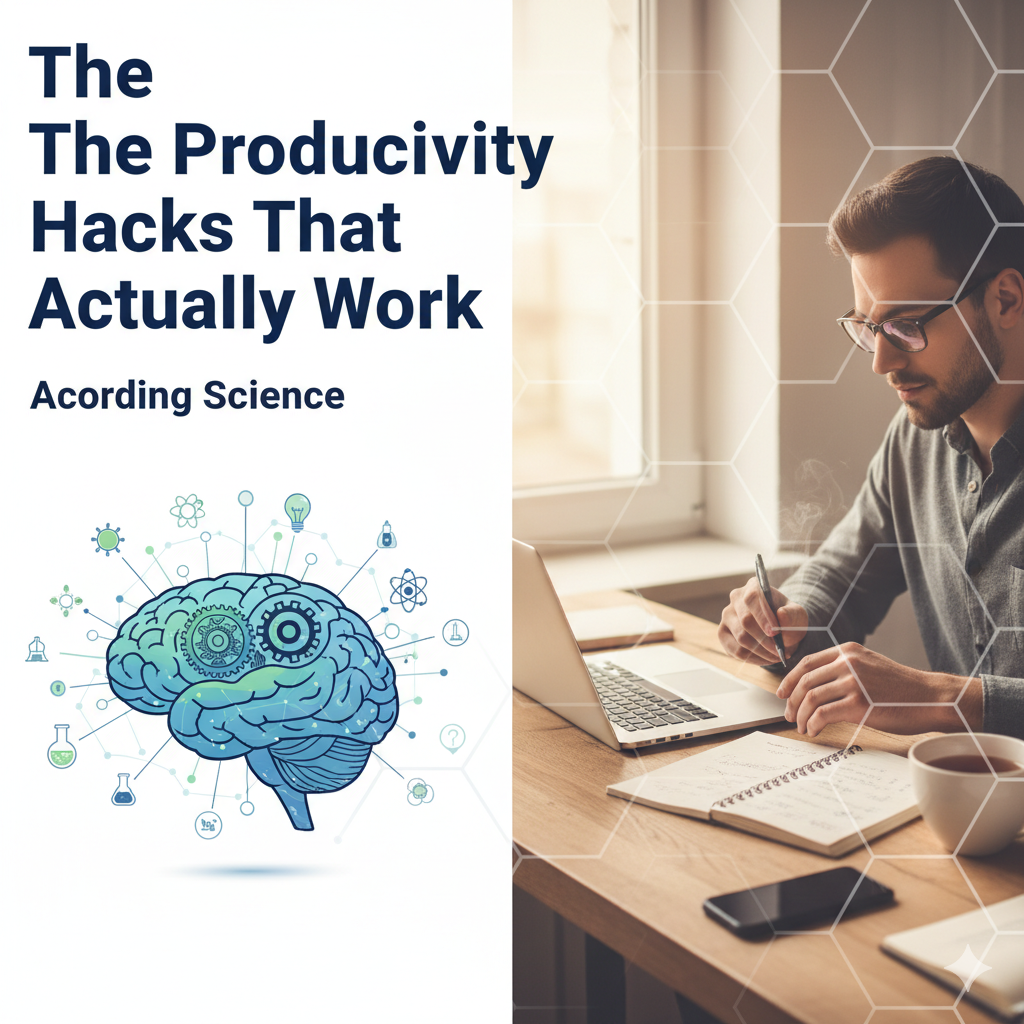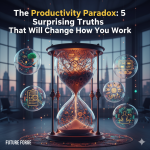In our hyper-connected world, the productivity paradox is a familiar feeling: a day packed with tasks and a suite of optimization apps, yet a nagging sense of having accomplished very little. The common response is to work harder or find the next time-management technique. But the real keys to reclaiming focus are often surprising, having less to do with willpower and more to do with understanding our own psychology and consciously managing our environment. This article moves beyond simple “hacks” to explore impactful, science-backed takeaways that can genuinely change how you work, allowing you to design a workflow that operates with your brain, not against it.
Your Brain is Built for Shortcuts, Not Spreadsheets
Your Brain is Designed to Be Lazy—And That’s a Superpower
We like to think of ourselves as rational beings who weigh pros and cons to make optimal decisions. Behavioral economics, however, tells a different story. Our brains are incredibly energy-intensive, consuming about 20% of our body’s energy despite making up less than 2% of its weight. As a survival mechanism designed to conserve this precious resource for genuine threats and opportunities, the brain evolved to rely on heuristics (mental shortcuts) and the fast, automatic thinking that Nobel laureate Daniel Kahneman calls “System 1.”
The surprising truth is that we “think much less than we think we think.” Most of our daily “decisions” are actually automatic reactions cued by our environment. This isn’t a modern flaw; it’s a highly efficient feature. True productivity doesn’t come from fighting this innate tendency with sheer force of will. It comes from understanding these mental shortcuts and biases to build better systems that guide our energy toward what truly matters.
“People do not always make rational decisions; rather, we often use other means to make decisions in complicated situations, especially when there is high uncertainty in the outcome.”
Just as our brains are wired to conserve energy, they are also easily overwhelmed by too many inputs. The most effective way to work with this reality is not to manage tasks better, but to get rid of them entirely.
To Get More Done, Do Less
Productivity Isn’t About Adding More Tasks—It’s About Aggressive Elimination
The most powerful and counter-intuitive secret to productivity isn’t about doing things faster; it’s about doing fewer things. Gaining significant efficiency—improvements greater than 30%—is nearly impossible without fundamentally changing a process or eliminating something entirely. We often fall into the trap of trying to optimize every task on our list, when the real win comes from asking which tasks shouldn’t be there at all.
This principle directly challenges the myth of multitasking, which is really “just doing more than one thing badly.” The key is to shift from a mindset of addition to one of aggressive subtraction. A powerful tool for this is the focusing question from Gary Keller’s book The One Thing:
“What’s the one thing that I can do now that if I focus on doing first and foremost is going to make everything else easier or unnecessary?”
A practical way to implement this is through a weekly reset ritual. This isn’t just a planning session; it’s an act of preventative maintenance for your focus. It’s a dedicated hour to pause, review priorities, and consciously identify what can be eliminated—to “lighten the load before it steals another ten hours of my life.”
Just as clearing our conceptual space by eliminating tasks can free up mental resources, clearing our physical space can have an equally powerful impact.
A Messy Desk Is More Than Just Messy
Your Desk’s Clutter Is Literally Draining Your Brainpower
Our brains are wired for order. When our physical environment is disorganized and cluttered, it acts as a constant, low-grade visual distraction. A study published in the Journal of Neuroscience found that physical clutter actively competes for your attention, draining your cognitive resources, reducing performance, and increasing stress. Piles of paper, disorganized files, and random items on your desk aren’t just an aesthetic issue; they create a cognitive load that makes it harder to focus.
The effect extends beyond our ability to work. In one highly relatable study, researchers found that people in a messy, disorganized kitchen ate twice as many cookies as those in an organized one. Clutter can elevate levels of the stress hormone cortisol, trigger avoidance strategies, and lead to poor choices. Decluttering your workspace isn’t just a tidying exercise. It’s a direct and powerful way to reduce mental fatigue and reclaim your ability to concentrate. A clear space supports a clear mind.
A clear physical space supports a clear mind, but the power of our environment extends beyond our personal desk to the design of the entire office.
The Best Office Designers Are Your Employees
Giving Up Control of Office Design Could Be a Manager’s Smartest Move
For decades, the conventional corporate approach has been to create standardized, ‘lean’ office spaces that reflect a uniform brand identity. However, striking research from the University of Exeter shows that this one-size-fits-all approach is a significant missed opportunity for productivity. The study revealed that employees who have control over the design of their personal workspace are not only happier and healthier but also remarkably more productive.
The researchers compared performance across different office setups:
- Employees in “enriched” spaces (decorated with plants and pictures by managers) were 17% more productive than those in ‘lean’ (bare and functional) offices.
- Employees in “empowered” spaces (who were given control to design the area themselves) were 32% more productive than their counterparts in ‘lean’ offices.
This highlights a deep psychological principle: the importance of an internal “locus of control.” When we can shape our surroundings, it enhances our sense of autonomy and personal identity, which are strongly linked to motivation, engagement, and satisfaction at work.
Giving employees control over their physical space is a powerful move, but even the best layout can be undermined by a less visible environmental factor: light.
The Most Overlooked Productivity Tool? Your Lightbulb.
The Color of Your Lighting Is Secretly Controlling Your Focus
Poor lighting is one of the most common workplace complaints, and for good reason. It can cause eye strain, headaches, and fatigue, all of which directly undermine concentration. But beyond simply having enough light, the color temperature of the light, measured in Kelvin (K), has a significant and often-overlooked impact on our mood and productivity.
Different light temperatures create different psychological states:
- Warm Lighting (< 3000K): This light emits a soft, yellowish hue, similar to a sunset or candlelight. It promotes feelings of relaxation and comfort, making it ideal for living rooms and bedrooms where a calm atmosphere is desired.
- Cool Lighting (> 5000K): This light mimics natural daylight with a bluish-white tone. It is energizing and stimulating, shown to enhance mental clarity, improve concentration, and boost alertness. This makes it the superior choice for offices and any workspace where focus is critical.
By consciously choosing the right light temperature for the task at hand, you can create an environment that either helps you unwind or energizes you for deep work.
Optimizing our visual environment with the right light is crucial, but our productivity is just as vulnerable to what enters our ears.
Your Biggest Distraction Isn’t Digital
Your Biggest Distraction Isn’t Your Phone—It’s Your Coworkers
While digital notifications are a major source of interruption, a comprehensive workplace acoustics study titled “What’s That Sound” revealed that the primary culprits of office noise are decidedly low-tech. The top two distractions reported by office workers are:
- Conversations among employees (71%)
- Phone conversations (67%)
The impact of these interruptions is staggering. Research from the University of California, Irvine, found that it takes an average of 23 minutes and 15 seconds to fully regain focus after being distracted. But the cost isn’t just measured in lost time. The study on office noise found that it leads to “increased stress” and “higher levels of anxiety.” The problem is so severe that it directly impacts talent retention, with a shocking 5% of employees reporting they had considered leaving their company due to noise.
Despite this clear cost to well-being and the bottom line, 44% of employers have done nothing to address office noise. This highlights a critical need for designated quiet areas and better acoustic design in our workspaces.
Conclusion: Engineer Your Environment, Don’t Just Manage Your Time
Instead of simply trying to muster more willpower, the science is clear: the most effective path to productivity involves architecting the conditions for deep work. Our environments are not passive backdrops; they are active co-pilots of our cognition. Rather than fighting our brain’s natural tendencies, we can consciously design our surroundings and routines to support them.
The takeaways in this article are more than just improvements; they are essential acts of cognitive hygiene. By eliminating tasks, decluttering your space, choosing the right light, and asserting control over your workspace, you stop leaking precious cognitive energy and start directing it toward what matters most.
What is the one small change you can make to your personal workspace this week to eliminate a hidden source of friction?












